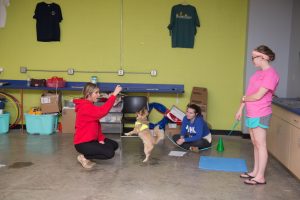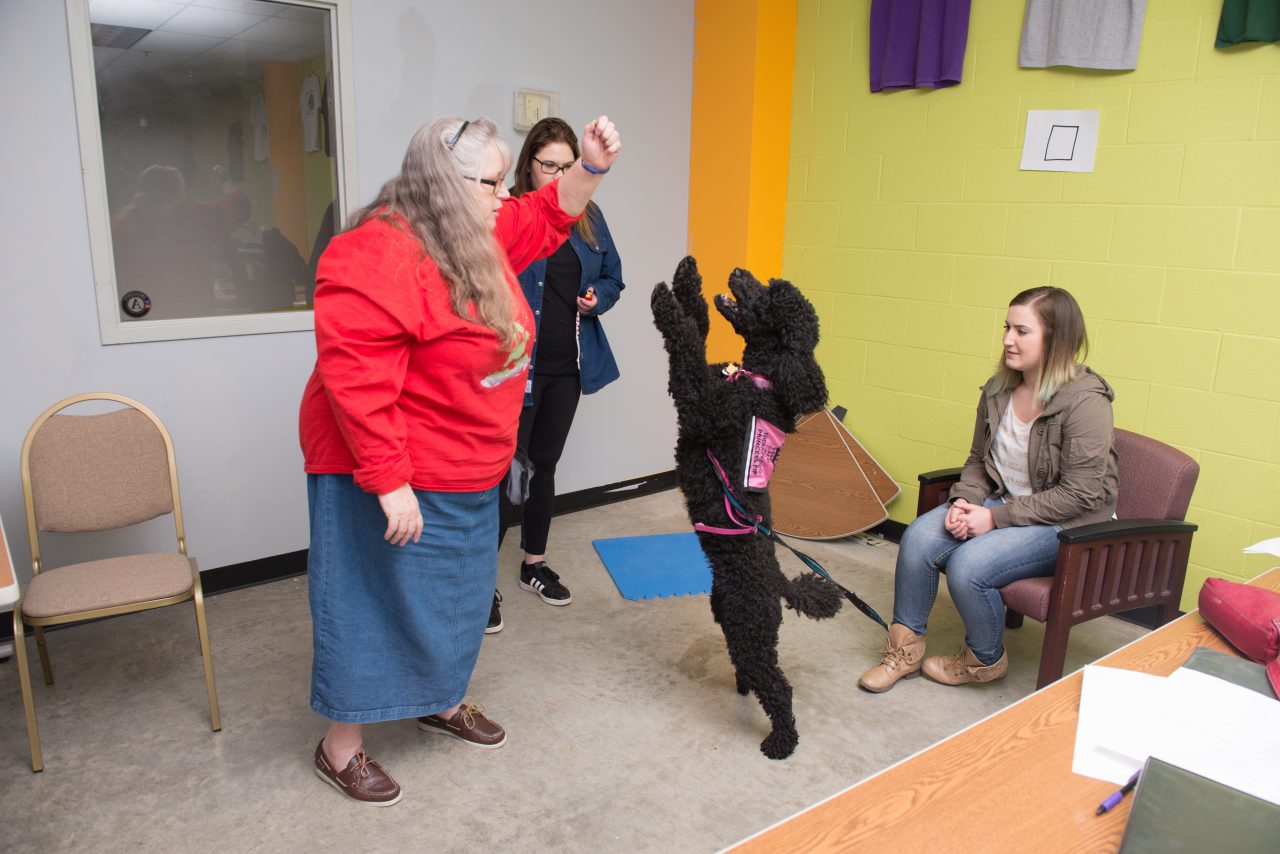Next to a large warehouse is a narrow hallway from which can be heard the echoes of barking dogs. Follow the sound and you will enter a small room packed with wagging tails and glossy puppy dog eyes eagerly looking up at their respective trainer. The dogs spin in circles and touch their muzzle to outstretched hands, duly rewarded with a small treat from trainers’ waist pouches.
What you see is the brainchild of Psychology Professor Valeri Farmer-Dougan: the Canine Behavior and Cognition Laboratory (CBCL). She sits in the room overseeing the dogs’ training, keeping track of the dogs that are in for the day and the training activities they need to perform, such as an IQ test. She assigns dogs to the trainers, who are Illinois State psychology students working in the lab for course credit.
Amid the bustle of moving students and the clamor of barking dogs, Farmer-Dougan doesn’t flinch.
“The trick is to remain calm,” Farmer-Dougan says. “If I or the trainers react to behavioral issues, we increase the anxiety in the room and further affect the dogs’ behavior.”
Farmer-Dougan and the trainers must stay calm, as the dogs exhibit behavioral issues often. After all, that’s why they’re there.
The lab works specifically with special needs dogs. The roughly 40 dogs a week the lab helps have aural or visual impairments, haven’t received proper training, or have a history of receiving abuse.
Take Mijo for example. The 6-month-old pit bull arrived at the lab in October. He had been found running through the streets, trailing blood behind him. He had been cut with a razor across his chest and on his ears and had acid poured on to his back.

The ultimate goal of the lab is to work with owners to show them that behavioral issues their dogs exhibit are fixable.
It would have been understandable for Mijo to exhibit aggression toward other humans for the rest of his life. But after Mijo’s training in the lab, he was adopted just a month later.
Farmer-Dougan said the secret to Mijo’s taming lies in the lab’s positive reinforcement training method.
“Positive reinforcement techniques prevent dogs from shutting down and not behaving. This is especially helpful for dogs who come in and have prior fears or behavioral issues,” Farmer-Dougan said. “Positive reinforcement helps to establish good connections between the dogs and their owners, rather than negative connections established through positive punishment.”
The key is patience. Farmer-Dougan said a lot of the time, she and the students end up teaching the owner what to do as much as the dogs. What Farmer-Dougan wants owners to understand is that anger won’t get them anywhere when correcting a dog’s behavior.
The ultimate goal of the lab is to work with owners to show them that behavioral issues their dogs exhibit are fixable. Student trainers will give the owners small homework assignments to complete with their pets at home. In the lab, dogs will be given problem-solving tasks like remembering the location of a treat after five minutes, finding ways to get to a treat in the back of a box, or retrieving a treat from underneath a cloth.
Dogs aren’t the only ones looking for something in the lab, however. Jennifer Gavin, a second-year graduate student in cognitive and behavioral sciences, has worked in the lab for three years researching canine cognition and behavioral patterns.
“We’re looking at the ways in which different reinforcement rates affect dogs’ likeliness to approach someone,” Gavin said. “We’ve found that it depends on the dog based on whether they were highly social or not. We’re also working with gestural cues, or how to get dogs who have impaired hearing to react to particular gestures like showing the back of your hand, which means sit.”
The lab is working on obtaining a larger space to accommodate more dogs and operate during the daytime, as the current Youth Build classroom in the strip mall off Wylie Drive that the lab operates out of doesn’t become available for use until 3 p.m. Farmer-Dougan hopes the lab can continue to save more dogs and provide student trainers with opportunities to apply psychological behavioral theory learned in class.
“Watching students make a breakthrough with a dog and think to themselves, ‘I did it,’ there’s nothing better. You realize they’ll never be the same again; they’ve made that connection with a dog,” Farmer-Dougan said. “They now know what it’s like to apply psychology in a lab setting and have a breakthrough. It’s a labor of love. Dogs give back as much as we give them.”

